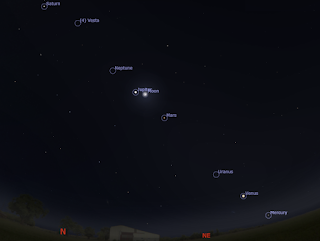[ad_1]
| Morning sky on Sunday June 12 as seen from Adelaide at 5:50 am ACST (90 minutes earlier than dawn). Saturn, Jupiter, Mars, Venus and Mercury kind a line (Uranus, Neptune and the Asteroid Vesta are within the line too, however all want not less than binoculars to see). Venus and Uranus are at their closest.The inset reveals the binocular look of Venus and Uranus right now. Comparable views might be seen from the remainder of Australia on the equal native time (90 minutes earlier than dawn, click on to embiggen). | Morning sky on Sunday June 19 as seen from Adelaide at 5:52am ACST (90 minutes earlier than dawn). The waning Moon is close to Saturn.
Comparable views might be seen from the remainder of Australia on the equal native time (90 minutes earlier than dawn, click on to embiggen). |
Morning sky on Wedensday June 22 as seen from Adelaide at 5:53 am ACST (90 minutes earlier than dawn). The waning Moon is close to Jupiter.
Comparable views might be seen from the remainder of Australia on the equal native time (90 minutes earlier than dawn, click on to embiggen). |
| Morning sky on Thursday June 23 as seen from Adelaide at 5:53 am ACST (90 minutes earlier than dawn). The crescent Moon is close to Mars.The inset reveals the binocular look of the Moon and Mars at 3:00 am native time. Comparable views might be seen from the remainder of Australia on the equal native time (90 minutes earlier than dawn, click on to embiggen). | Morning sky on Saturday June 25 as seen from Adelaide at 5:53 am ACST (90 minutes earlier than dawn). The Moon and and Uranus are at their closest (occultation in WA, NT and FNQ). The inset reveals the binocular look of the Moon and Uranus right now. Comparable views might be seen from the remainder of Australia besides the occulting states on the equal native time (90 minutes earlier than dawn, click on to embiggen). | Morning sky on Sunday June 26 as seen from Adelaide at 6:24 am ACST (60 minutes earlier than dawn). The crescent moon kinds a line with Venus, Aldebaran and Mercury, with the Pleiades cluster shut by.
Comparable views might be seen from the remainder of Australia on the equal native time (60 minutes earlier than dawn, click on to embiggen). |
Over the following three weeks it is possible for you to to see a reasonably uncommon sight, if in case you have clear morning skies. All 5 vibrant classical planets are lined up within the order they’re from the Solar. Mercury, Venus, Mars, Jupiter and Saturn. In February 2016 we additionally had 5 vibrant planets within the morning skies however the lineup was Mercury, Venus, Saturn, Mars and Jupiter. We have now to return 21 December 2004 to have all 5 planets within the morning sky in photo voltaic order.
Additionally, not like the opposite occasions we had all the intense classical planets collectively within the morning, we even have all the opposite planets (Uranus, Neptune), the Dwarf planet Pluto and the Asteroid 4 Vesta. These will not be is photo voltaic system order.
To make up for this on the twelfth we’ve an in depth method of Venus and Uranus. The Moon joins the line-up from the nineteenth, and we’ve plenty of good shut Moon approaches, with the Moon and Uranus being shut on the twenty fifth and occultations in Cairns (Daybreak), Darwin, Alice Springs and Perth.
On the twenty sixth Venus and the skinny crescent Moon are shut, the Pleiades and
Aldebaran and Mercury make this a pretty sight. On the twenty seventh the skinny crescent Moon kinds a rectangle with Mercury, Venus and Aldebaran. On the thirtieth Venus
kinds a second eye for Taurus the Bull.
Labels: 4 Vesta, Jupiter, Mars, Mercury, Neptune, Occultation, Saturn, unaided eye, Uranus, Venus
[ad_2]









